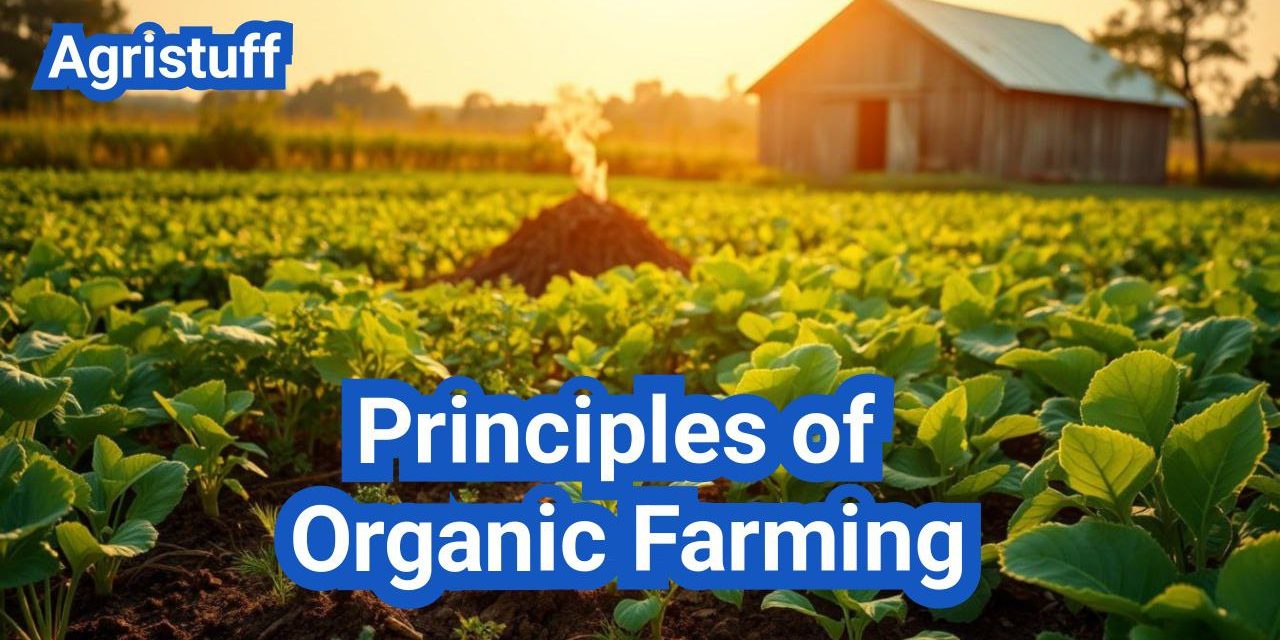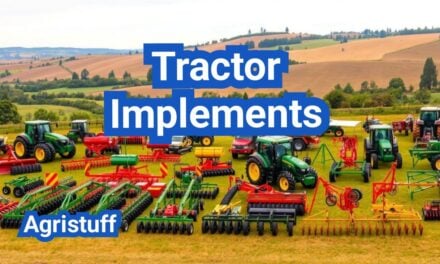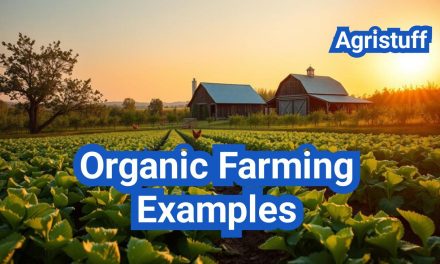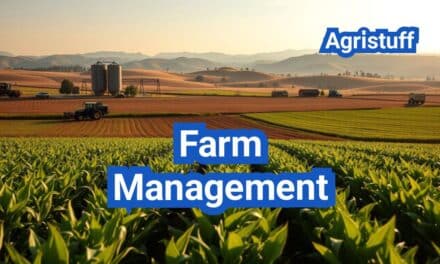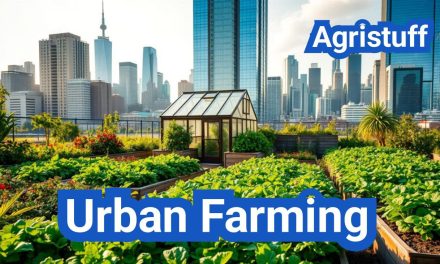Organic farming is gaining prominence worldwide due to its potential to promote sustainable farming practices.
The core principles of organic farming are rooted in four key areas: Health, Ecology, Fairness, and Care. These principles serve as the foundation for organic farming practices, ensuring that agricultural methods are environmentally friendly and socially responsible.
By focusing on these principles, organic agriculture not only enhances the health of ecosystems and biodiversity but also promotes fair trade practices and care for the well-being of farmers and consumers alike.
Key Takeaways
- Organic farming is based on four core principles: Health, Ecology, Fairness, and Care.
- These principles guide sustainable farming practices.
- Organic farming promotes environmental sustainability and social responsibility.
- It enhances ecosystem health and biodiversity.
- Fair trade practices are a cornerstone of organic agriculture.
Understanding Organic Farming
Organic farming represents a holistic approach to agriculture, focusing on the health of the soil, ecosystems, and people. It is based on the principles of health, ecology, fairness, and care, aiming to create a sustainable and environmentally friendly farming practice.
Definition and Philosophy
The definition of organic farming encompasses a farming system that avoids the use of synthetic fertilizers, pesticides, and genetically modified organisms. It emphasizes the use of natural processes and materials to maintain soil fertility and control pests and diseases. The philosophy behind organic farming is rooted in the belief that agricultural practices should work in harmony with nature, rather than against it, to achieve ecological balance.
Organic farming practices are designed to promote biodiversity, improve soil health, and efficiently use water and other resources. By focusing on the well-being of the soil and ecosystems, organic farming contributes to a healthier environment and produces food that is free from harmful chemicals.
Historical Development of Organic Practices
The history of organic practices dates back to ancient times when farmers relied on natural methods to cultivate crops. The modern concept of organic farming, however, began to take shape in the early 20th century as a response to the increasing use of chemical fertilizers and pesticides. Pioneers in organic farming, such as Sir Albert Howard and Lady Eve Balfour, played significant roles in promoting the benefits of organic agriculture through their research and advocacy.
Modern Organic Movement
The modern organic movement has evolved significantly, with a growing demand for organic products driving its expansion. Today, organic farming is practiced worldwide, with many countries establishing standards and certification programs to ensure the integrity of organic produce. The movement continues to grow, driven by consumer interest in sustainable and healthy food options.
| Key Principles | Description | Benefits |
|---|---|---|
| Health | Maintaining and enhancing the health of soils, plants, animals, and humans. | Produces healthy food, improves soil fertility. |
| Ecology | Working with natural systems and cycles. | Promotes biodiversity, ecological balance. |
| Fairness | Ensuring fairness and equity for all stakeholders. | Improves livelihoods for farmers, fair trade practices. |
| Care | Managing resources with care and responsibility. | Enhances sustainability, protects the environment. |
Principles of Organic Farming

Soil health is the cornerstone of organic farming, influencing every aspect of the ecosystem. Organic farming principles prioritize maintaining and enhancing soil health to ensure sustainable agricultural practices. This approach not only improves crop yields but also contributes to environmental conservation.
Nurturing soil health involves understanding its complex ecosystem. Soil is teeming with microbial life that plays a crucial role in decomposing organic matter, fixing nitrogen, and fighting plant diseases. By fostering this microbial life, farmers can reduce their reliance on synthetic fertilizers.
Soil Health as a Foundation
Soil health is foundational to organic farming because it directly affects the fertility and structure of the soil. Healthy soil retains water better, supports more biodiversity, and is more resilient to erosion.
Microbial Life Importance
Microbial life is essential for breaking down organic matter into nutrients that plants can absorb. Beneficial microbes also form symbiotic relationships with plant roots, enhancing their ability to uptake nutrients.
Organic Matter Cycling
Organic matter cycling involves the decomposition and recycling of plant residues and other organic materials. This process not only replenishes soil nutrients but also improves soil structure, allowing for better aeration and water infiltration.
By focusing on soil health through practices like microbial life enhancement and organic matter cycling, farmers can achieve more sustainable farming outcomes. This holistic approach supports ecosystem services, improves crop resilience, and contributes to a healthier environment.
In conclusion, the principles of organic farming emphasize the importance of maintaining soil health. By understanding and leveraging the complex interactions within the soil ecosystem, farmers can create more sustainable and productive agricultural systems.
Building and Maintaining Healthy Soil
Maintaining healthy soil is essential for organic farming practices. Soil health directly impacts the productivity and sustainability of organic farms. Healthy soil supports a diverse range of microbial life, which is crucial for nutrient cycling and plant health.
Soil Testing Techniques
Soil testing is a critical step in understanding and improving soil health. By analyzing the soil’s composition and nutrient content, farmers can make informed decisions about fertilizers and soil amendments.
DIY Soil Tests
DIY soil tests offer a cost-effective way to monitor soil health. Simple tests, such as the jar test for soil texture or using pH test strips, can provide valuable insights into soil composition.
Professional Analysis
For a more detailed analysis, professional soil testing services can provide comprehensive data on soil nutrients, contaminants, and microbial activity. This information is invaluable for developing targeted soil improvement strategies.
Effective soil testing, whether through DIY methods or professional analysis, is key to maintaining healthy soil. By understanding the soil’s condition, farmers can adopt sustainable practices that enhance soil fertility and structure, ultimately leading to more productive and resilient organic farms.
- Regular soil testing helps in early detection of nutrient deficiencies.
- Professional analysis can identify soil contaminants and recommend remediation strategies.
- DIY tests empower farmers to make timely adjustments to their soil management practices.
“Soil is the foundation of agriculture, and its health is critical to the success of organic farming. By prioritizing soil health, farmers can improve crop yields, reduce environmental impact, and contribute to a more sustainable food system.”
In conclusion, building and maintaining healthy soil through regular testing and analysis is fundamental to the success of organic farming. By leveraging both DIY and professional soil testing techniques, farmers can ensure their soil remains fertile and productive.
Natural Fertilization Methods
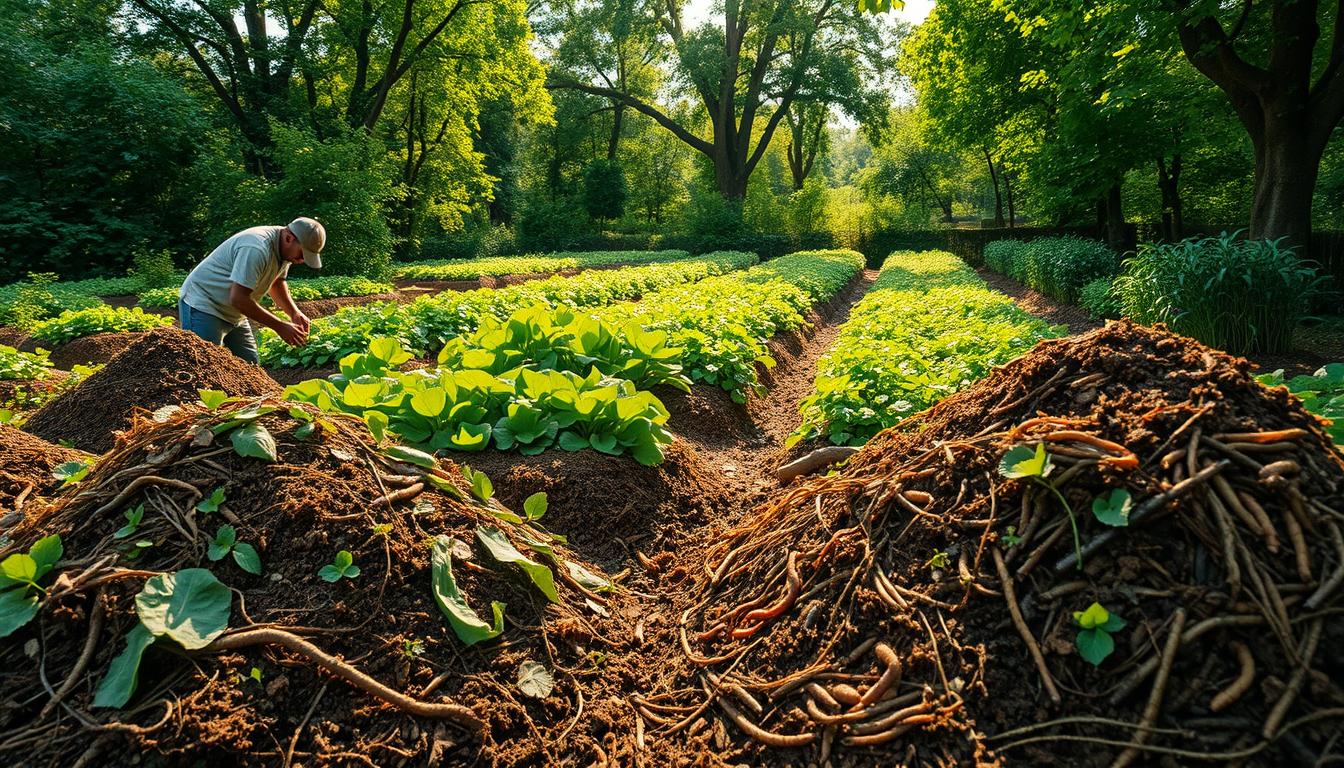
Enhancing soil fertility through natural means is a key aspect of sustainable agriculture. Natural fertilization methods are essential for maintaining soil health, promoting plant growth, and ensuring a balanced ecosystem. These methods not only improve soil fertility but also contribute to environmental sustainability by reducing the need for synthetic fertilizers.
Composting Fundamentals
Composting is a cornerstone of natural fertilization, involving the decomposition of organic materials to create a nutrient-rich soil amendment. This process enhances soil structure, increases the soil’s water-holding capacity, and supports beneficial microbial activity.
Building Compost Piles
To build effective compost piles, it’s crucial to balance “green” materials (like kitchen scraps and grass clippings) with “brown” materials (such as dried leaves and straw). This balance ensures optimal decomposition and minimizes odors.
Compost Tea Applications
Compost tea is a liquid solution made by steeping compost in water. It’s used to promote beneficial microbial activity in the soil, enhancing plant health and resilience. Regular application of compost tea can improve soil fertility and structure.
The benefits of natural fertilization methods, such as composting, are multifaceted. They not only enhance soil health but also support plant growth and contribute to a more sustainable agricultural practice.
| Method | Description | Benefits |
|---|---|---|
| Composting | Decomposition of organic materials | Enhances soil structure, increases water-holding capacity |
| Compost Tea | Liquid solution from steeping compost | Promotes beneficial microbial activity, enhances plant health |
Sustainable Water Management
Implementing sustainable water management strategies is vital for organic farmers to conserve water resources. Effective water management not only ensures the health and productivity of crops but also contributes to the overall sustainability of the farming system.
Water conservation is a critical aspect of sustainable water management. Organic farming relies on various techniques to minimize water waste and optimize its use.
Effective Conservation Techniques
Several methods can be employed to conserve water in organic farming. These include:
- Improving soil health through the addition of organic matter
- Using mulching to reduce evaporation and retain soil moisture
- Implementing efficient irrigation systems
Mulching for Moisture Retention
Mulching is a simple yet effective technique for retaining soil moisture. By applying a layer of organic material to the soil surface, farmers can significantly reduce water loss due to evaporation.
Rainwater Harvesting
Rainwater harvesting is another valuable strategy for sustainable water management. Collecting and storing rainwater for later use can help reduce reliance on other water sources, lowering the demand on groundwater and surface water resources.
By adopting these water conservation techniques, organic farmers can enhance the sustainability of their operations, ensuring a more resilient farming system.
Natural Pest Management Strategies

The key to successful organic farming lies in understanding and implementing effective natural pest management strategies. These strategies not only help in controlling pests but also contribute to maintaining ecological balance.
One of the cornerstones of natural pest management is the use of beneficial insects and pollinators. These organisms play a crucial role in controlling pest populations and enhancing biodiversity within the farm ecosystem.
Beneficial Insects and Pollinators
Beneficial insects such as ladybugs, lacewings, and parasitic wasps are natural predators of many pests that can damage crops. By creating an environment that attracts these beneficial insects, farmers can reduce their reliance on chemical pesticides.
Attracting Natural Predators
To attract natural predators, farmers can plant a variety of flowers that provide nectar and pollen, such as marigolds and sunflowers. These plants serve as a food source for beneficial insects, encouraging them to stay in the area and prey on pests.
Creating Insect Habitats
Creating habitats for beneficial insects involves planting native vegetation and maintaining ecological corridors. This approach not only supports biodiversity but also enhances the ecosystem’s ability to control pests naturally.
By implementing these natural pest management strategies, farmers can achieve a more sustainable and balanced agricultural ecosystem. This not only benefits the environment but also contributes to healthier crops and improved yields.
Ecological balance is maintained through the diverse interactions between different species within the farm ecosystem. This balance is crucial for long-term sustainability and productivity.
In conclusion, natural pest management strategies are vital for organic farming. By leveraging the power of beneficial insects and pollinators, farmers can protect their crops while preserving the health of the ecosystem.
Crop Rotation and Diversity
Crop rotation and diversity are essential components of sustainable farming, contributing to improved soil health and reduced pest and disease pressure. By rotating crops, farmers and gardeners can enhance ecosystem services and promote biodiversity, leading to more resilient and productive agricultural systems.
Crop rotation involves changing the type of crops grown on a specific area of land from one season or year to another. This practice helps in maintaining soil fertility, reducing the reliance on chemical fertilizers, and minimizing the buildup of pests and diseases.
Planning Effective Crop Rotations
Effective crop rotation requires careful planning, taking into account the different needs and characteristics of various crops. It’s essential to understand the growth patterns, soil requirements, and potential pest and disease issues associated with each crop.
Plant Family Groupings
One approach to planning crop rotations is to group crops by their plant families. For example, crops within the Brassica family (such as broccoli and kale) share similar characteristics and may be susceptible to similar pests and diseases. Rotating between different plant families can help mitigate these risks.
Multi-Year Rotation Plans
Developing a multi-year rotation plan can further enhance the benefits of crop rotation. This involves creating a schedule that outlines the sequence of crops to be grown over several years, allowing for a more diverse and resilient agricultural ecosystem.
By incorporating crop rotation and diversity into farming and gardening practices, individuals can contribute to biodiversity preservation and promote sustainable farming methods. This not only benefits the environment but also leads to more sustainable and productive agricultural outcomes.
Weed Management Without Chemicals

Managing weeds without chemicals is a key aspect of organic farming practices. Weeds compete with crops for water, nutrients, and light, potentially reducing yields and affecting farm productivity. Effective weed management is crucial for maintaining a healthy and productive organic farm.
One of the most effective methods for managing weeds without chemicals is mulching. Mulching involves covering the soil with a layer of organic material to suppress weed growth, retain moisture, and regulate soil temperature.
Mulching Methods
Mulching is a simple yet effective technique for weed control. By applying a layer of organic mulch, farmers can significantly reduce the need for chemical herbicides and cultivate a more sustainable farming environment.
Organic Mulch Options
There are several organic mulch options available, including straw, wood chips, and leaves. Each of these materials has its own benefits and can be chosen based on availability and specific farming needs.
Application Techniques
The application of mulch involves spreading it evenly over the soil surface. The thickness of the mulch layer can vary depending on the type of mulch used and the specific requirements of the crop being grown.
A comparative analysis of different mulching materials is provided in the table below:
| Mulch Type | Weed Suppression | Moisture Retention |
|---|---|---|
| Straw | High | Good |
| Wood Chips | Very High | Excellent |
| Leaves | Moderate | Good |
“Mulching is a powerful tool in the fight against weeds. By choosing the right mulch and applying it correctly, farmers can reduce their reliance on chemical herbicides and create a more sustainable farming system.”
In conclusion, mulching is a highly effective method for managing weeds without chemicals. By selecting the appropriate organic mulch and applying it correctly, farmers can improve soil health, reduce weed growth, and promote a more sustainable farming environment.
Selecting Seeds and Plants for Organic Gardens

Choosing the right seeds is a crucial step in creating a thriving organic garden. The quality of the seeds directly impacts the health and productivity of the plants. Organic gardeners should focus on selecting seeds that are suitable for organic gardening conditions.
When it comes to selecting seeds, gardeners often debate between heirloom and hybrid varieties. Understanding the differences between these types is essential for making informed decisions.
Heirloom vs. Hybrid Varieties
Heirloom varieties are open-pollinated, meaning they can be saved and replanted from seed. They offer unique flavors and characteristics but may not be as disease-resistant as hybrid varieties. Hybrid varieties, on the other hand, are bred for specific traits like disease resistance and higher yields.
Seed Saving Benefits
One of the significant benefits of heirloom varieties is the ability to save seeds from your harvest. This practice not only saves money but also helps in preserving heritage varieties. As noted by gardening expert, “Seed saving is an art that connects us to our agricultural heritage.”
“The ability to save seeds is a powerful tool for gardeners, allowing them to adapt plants to their local environment over time.”
Performance Considerations
When choosing between heirloom and hybrid varieties, consider the performance needs of your garden. If you’re looking for higher yields and disease resistance, hybrid varieties might be the better choice. However, if you’re interested in preserving traditional varieties and practicing seed saving, heirloom varieties are ideal.
In conclusion, selecting the right seeds and plants for your organic garden involves considering factors like disease resistance, yield, and the ability to save seeds. By understanding the differences between heirloom and hybrid varieties, gardeners can make informed decisions that align with their gardening goals.
Setting Up Your Organic Garden

Setting up an organic garden involves several key steps, beginning with site selection and planning. Proper site selection and planning are essential for a thriving organic garden, as they lay the groundwork for a healthy ecosystem.
Site Selection and Planning
The first step in setting up your organic garden is to choose a suitable location. This involves assessing the site’s conditions, including sunlight, soil quality, and drainage.
Sunlight and Shade Analysis
Conducting a sunlight and shade analysis is crucial. Most vegetables and fruits require at least 6 hours of direct sunlight per day. Observe your garden throughout the day to determine the sunniest spots. Consider using a sunlight tracker or simply observing the area over time.
Garden Layout Design
Designing your garden layout is the next critical step. Consider the mature size of the plants, their spacing needs, and the pathways between beds. A well-planned layout ensures good air circulation, reduces soil compaction, and makes maintenance easier.
Here’s an example of a simple garden layout plan:
| Bed Number | Plant Type | Spacing |
|---|---|---|
| 1 | Tomatoes | 2-3 feet |
| 2 | Leafy Greens | 4-6 inches |
| 3 | Carrots | 1-2 inches |
By carefully planning your garden’s layout and selecting the right site, you set the stage for a successful and productive organic garden.
- Choose a location with good drainage.
- Ensure adequate sunlight for your crops.
- Plan your garden layout to optimize space and reduce maintenance.
By following these guidelines, you can create an organic garden that is both productive and sustainable.
Seasonal Organic Gardening Practices

To maximize the potential of an organic garden, gardeners must be attuned to the rhythms of the seasons and adjust their strategies accordingly. Seasonal organic gardening practices are not just about reacting to changes in the weather; they’re about anticipating and preparing for the needs of your garden throughout the year.
“The way to a healthy garden is through understanding and working with nature,” as emphasized by organic gardening principles. Spring is a critical season for setting the stage for a successful year.
Spring Preparations
Spring preparations are a pivotal part of seasonal organic gardening practices. As the soil becomes workable after winter, gardeners can start preparing their beds for the new growing season.
Soil Warming Techniques
One effective method for spring preparation is using soil warming techniques. Techniques such as using black plastic mulch or row covers can help warm the soil, encouraging earlier planting and faster growth.
Early Season Planting
Early season planting is another crucial aspect of spring gardening. By selecting varieties that are resistant to cooler temperatures, gardeners can get a head start on the growing season. Crops like spinach, lettuce, and peas are ideal for early planting.
As Rodale’s Organic Life suggests, “Starting seeds indoors and then transplanting them outside when the weather warms can give your garden a significant boost.” This approach allows gardeners to make the most of the growing season.
By understanding and implementing these seasonal organic gardening practices, gardeners can create a thriving and resilient garden ecosystem. Whether it’s through soil warming techniques or early season planting, every step taken in the spring can significantly impact the overall health and productivity of the garden.
- Monitor weather forecasts to anticipate frosts and protect young plants.
- Use compost and organic fertilizers to enrich the soil.
- Plan your garden layout to maximize space and sunlight.
By following these guidelines and adapting to the changing seasons, organic gardeners can enjoy a bountiful harvest and a beautiful garden throughout the year.
Harvesting and Storing Organic Produce

The moment of harvesting is crucial in organic farming, as it directly impacts the quality of the produce. Proper harvesting and storage techniques are essential for maintaining the nutritional value and quality of organic crops.
Optimal Harvesting Techniques
Optimal harvesting techniques vary depending on the type of crop. Understanding when and how to harvest is crucial for achieving peak nutrition and flavor.
Timing for Peak Nutrition
Harvesting at the right time ensures that the produce is at its peak nutritional value. For leafy greens, this means harvesting when they are young and tender. For fruits, it’s about ripeness, which can be determined by color, texture, and taste.
Harvest Methods by Crop Type
Different crops require different harvesting methods. For example, root vegetables like carrots and beets are harvested by carefully loosening the soil around them, while grains are harvested by cutting the stalks.
| Crop Type | Harvesting Method | Storage Tips |
|---|---|---|
| Leafy Greens | Harvest when young and tender | Store in a cool, dry place |
| Root Vegetables | Loosen soil, then pull out | Store in a root cellar or fridge |
| Fruits | Harvest when ripe | Store at room temperature or in the fridge |
By mastering the art of harvesting and storing organic produce, gardeners can enjoy a bountiful harvest that retains its nutritional value and flavor.
Troubleshooting Common Organic Gardening Issues

Troubleshooting is a critical aspect of organic gardening, enabling gardeners to identify and address problems before they escalate. Being able to diagnose and address common issues is a key skill for organic gardeners, ensuring the health and productivity of their gardens.
Diagnosing Plant Problems
Accurate diagnosis is the first step in resolving plant problems. Gardeners should inspect their plants regularly, looking for signs of stress, disease, or pest activity. Careful observation is crucial in identifying issues early on.
Nutrient Deficiency Identification
Nutrient deficiencies can manifest in various ways, such as yellowing leaves or stunted growth. Soil testing can help identify nutrient deficiencies, allowing gardeners to apply targeted amendments to address the issue.
Pest vs. Disease Symptoms
Distinguishing between pest damage and disease symptoms is essential for effective troubleshooting. Pests typically cause physical damage, while diseases often result in abnormal growth patterns or discoloration. Understanding these differences helps gardeners apply the correct treatment.
By developing a systematic approach to troubleshooting, organic gardeners can address issues efficiently, minimizing the impact on their gardens. Regular monitoring, accurate diagnosis, and appropriate intervention are key to successful organic gardening.
Conclusion
The principles of organic farming provide a foundation for sustainable gardening practices that promote ecological balance. By adopting these methods, gardeners can create a healthy and thriving ecosystem that benefits both the environment and their own well-being.
Throughout this article, we have explored the key principles and practices of organic farming, including building and maintaining healthy soil, natural fertilization methods, sustainable water management, and natural pest management strategies. By implementing these techniques, gardeners can reduce their environmental impact while cultivating a diverse and resilient garden.
Sustainable gardening practices, such as crop rotation and diversity, weed management without chemicals, and selecting seeds and plants suitable for organic gardens, are essential for maintaining ecological balance. By embracing these principles, gardeners can contribute to a healthier environment and enjoy the many benefits of organic gardening.
As we move forward, it is essential to continue promoting and adopting sustainable gardening practices that prioritize ecological balance. By doing so, we can create a more sustainable future for generations to come.
FAQ
What is organic farming and how does it differ from conventional farming?
Organic farming is a method of crop and livestock production that avoids the use of synthetic fertilizers, pesticides, and genetically modified organisms. It differs from conventional farming in its emphasis on natural processes and materials.
Why is soil health important in organic farming?
Soil health is crucial in organic farming as it provides the foundation for plant growth, supports biodiversity, and helps to mitigate climate change. Healthy soil is teeming with microbial life, which aids in the decomposition of organic matter and the cycling of nutrients.
What are some effective methods for building and maintaining healthy soil?
Techniques such as composting, mulching, and cover cropping can help to improve soil health. Regular soil testing is also essential to determine nutrient levels and pH.
How can I naturally fertilize my soil without using synthetic fertilizers?
Composting is a highly effective method of natural fertilization. It involves breaking down organic materials such as food waste and leaves to create a nutrient-rich soil amendment.
What are some sustainable water management practices for organic farming?
Techniques such as mulching, drip irrigation, and rainwater harvesting can help to conserve water and reduce waste. These methods also help to maintain soil health and reduce the risk of water pollution.
How can I manage pests and diseases in my organic garden without using chemicals?
Strategies such as introducing beneficial insects, practicing crop rotation, and using physical barriers can help to manage pests and diseases. Maintaining healthy soil and providing a balanced ecosystem also helps to prevent pest and disease issues.
What is crop rotation and how can it benefit my organic garden?
Crop rotation involves changing the type of crops grown in a specific area to maintain soil health, reduce pests and diseases, and increase biodiversity. It can help to improve soil fertility, structure, and overall ecosystem health.
How can I manage weeds in my organic garden without using herbicides?
Techniques such as mulching, hand-weeding, and using physical barriers can help to manage weeds. Maintaining healthy soil and providing a balanced ecosystem also helps to prevent weed growth.
What are the benefits of using heirloom varieties in my organic garden?
Heirloom varieties are often more diverse and resilient than hybrid varieties, and can provide a more robust and adaptable crop. They also help to preserve genetic diversity and promote biodiversity.
How can I prepare my organic garden for different seasons?
Techniques such as mulching, cover cropping, and adjusting planting schedules can help to prepare your garden for different seasons. Understanding the specific needs of your crops and soil during different times of the year is also essential.
What are some optimal harvesting techniques for organic produce?
Techniques such as harvesting at peak ripeness, handling produce gently, and storing produce properly can help to maintain the quality and nutritional value of your organic produce.
How can I troubleshoot common issues in my organic garden?
Techniques such as monitoring soil health, inspecting plants regularly, and identifying pests and diseases can help to diagnose issues. Understanding the underlying causes of problems and using natural and integrated approaches can help to resolve issues.

